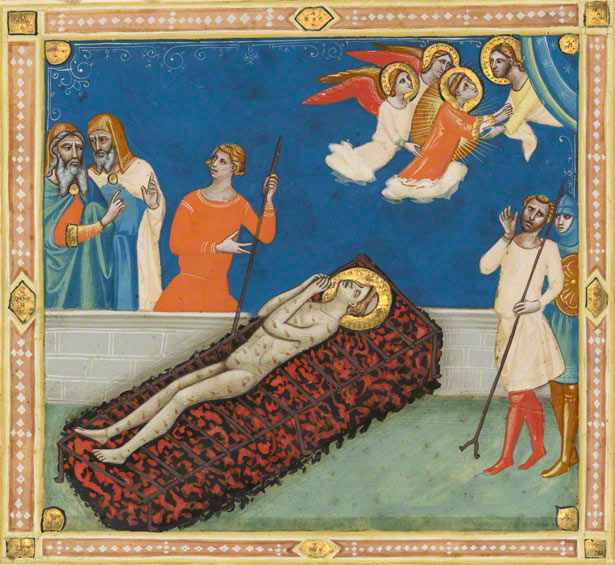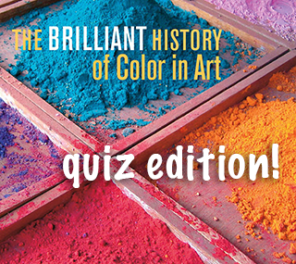In the early 1300s, 150 years before Leonardo and Michelangelo walked its streets, Florence was a hotbed of artistic production and creativity. Three works in the Getty Museum’s collection produced in the city at this dynamic moment—all by the same artist—demonstrate the artistic vibrancy of this place and time.

The Ascension of Christ from the Laudario of Sant’Agnese, about 1340, Pacino di Bonaguida. Tempera and gold on parchment, 17 1/2 x 12 1/2 in. (44.4 x 31.8 cm). The J. Paul Getty Museum, Ms. 80a, verso

This glittering page comes from the Laudario of Sant’Agnese, the most lavish manuscript commission the first half of the 14th century.
Expressions of awe and wonder appear on the faces of the twelve apostles and the Virgin Mary as they shade their eyes and stare up at the radiant figure of Christ rising to heaven above, while angels standing in the margins playing instruments mirror the music and the first words of the hymn written below, which the faithful once sang.
Another leaf from the same manuscript displays a powerful scene of martyrdom.

The Martyrdom of Saint Lawrence from the Laudario of Sant’Agnese, about 1340, Pacino di Bonaguida. Tempera and gold leaf on parchment, 7 1/2 x 8 3/16 in. (19 x 20.8 cm). The J. Paul Getty Museum, Ms. 80b, verso

Roman deacon Saint Lawrence, who refused to hand over church funds to the emperor Decius, is punished by his torturers by being laid out naked on a hot grill glowing with flickering flames.
In this moment of extreme torment, Saint Lawrence appears with his face upturned in a state of religious ecstasy.
In the third and most unusual work, the figure of Christ, glowing in gilt relief, hovers among his twelve apostles, releasing Holy Communion from the center of his body via tubes that extend to his followers’ mouths. A single golden stream descends directly down upon the diminutive figure of Florentine holy man Chiarito del Voglia, who kneels at the base of the painting, and who was responsible for commissioning this work.

Chiarito Tabernacle, 1340s, Pacino di Bonaguida. Below, a detail of Chiarito del Voglia receiving Holy Communion from Christ. Gilded gesso and tempera on panel, 39 7/8 x 44 11/16 in. (101.3 x 113.5 cm). The J. Paul Getty Museum, 85.PB.311

These compelling and visually stunning images are the creations of artist Pacino di Bonaguida (active ca. 1303–ca. 1347), who, though relatively little known today, was at the forefront of artistic production in early 1300s Florence. A hugely prolific and versatile artist who was both a panel painter and a manuscript illuminator, Pacino dominated the market for illuminated manuscripts in that city, producing many of the first illustrated copies of the Divine Comedy by Florentine poet Dante Alighieri, as well as the lavish Laudario of Sant’Agnese. In fact, this artist and these works in the Museum’s collection were our inspiration for the exhibition Florence at the Dawn of the Renaissance: Painting and Illumination, 1300-1350, which opens at the Getty Center on November 13.
It’s been six years since this painting and these manuscripts first led us to look more closely at the enigmatic figure of Pacino di Bonaguida, and it’s amazing to realize that from these three works has now grown an exhibition of over 90 objects from approximately 50 international lenders.
Pacino was the younger contemporary of the revolutionary artist Giotto di Bondone (ca. 1267–1337), the Florentine native son who took the Italian peninsula by storm around 1300 with his remarkable frescoes and panel paintings. While Giotto has loomed large over this well-studied period of art, in an effort to tell the full story of painting during this period, we delved deeper into the material that survives and approached it in new ways. Why was Florence such a hotbed of artistic production at this moment, and what spawned the new naturalism and iconographic creativity that advanced artistic representation? What about the artists of the time who were equally skilled as manuscript illuminators and panel painters, like Pacino and others? How can we better understand how artists worked at this time, both in terms of their painting techniques and materials, and in terms of how they interacted with one another in workshops?
From the beginning, the pursuit of answering these questions has been a team effort, with curators and conservators from the Getty Museum and scientists from the Getty Conservation Institute (GCI) taking part. My colleague Catherine Schmidt Patterson and I recently detailed these collaborations in an article in the GCI’s newsletter.

View of Florence, Italy. © Simon Topp
The exhibition celebrates a famous period in the history of one of the most beloved and beautiful cities in the world, a city that for centuries has inspired artists, poets, scholars, and tourists alike. Indeed, it is difficult not to become fascinated with Florence at the dawn of the Renaissance, and this fall we hope you will take a moment to be captivated, not only by the great beauty of the paintings and illuminations produced there, but also by their more unexpected and eye-opening details.




Comments on this post are now closed.
Trackbacks/Pingbacks